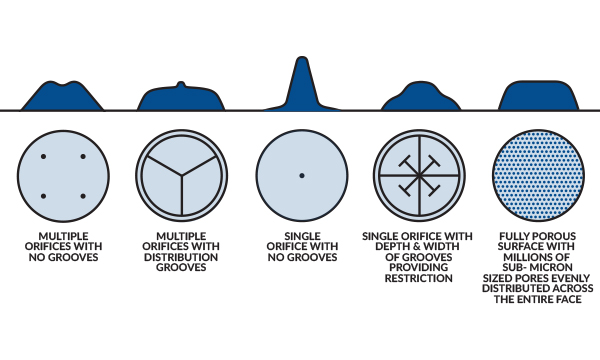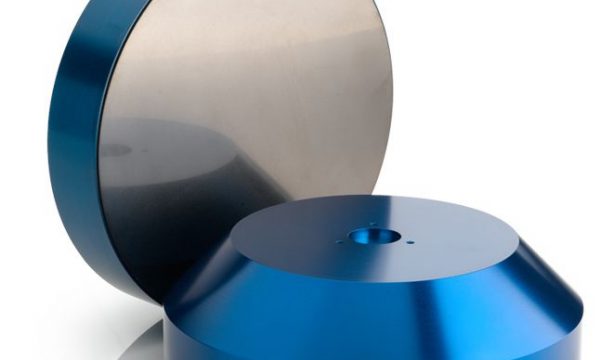Porous Media Technology vs. Orifice Compensation
When precision demands that you consider air bearings for your application, your next question is likely to be, “What kind?”
There are two primary approaches for producing the compensating effect in air bearings:
Orifice compensation – An approach that forces air through one or more holes drilled in a bearing surface.
Porous media compensation – An approach that uses the natural permeability of a porous carbon material to control the flow of air to the bearing face.
Orifice Air Bearings
When using conventional orifice compensation, you need to match the bearing size with the right number, size, and distribution of what are usually jeweled holes to maintain stability during operation. Sometimes grooves are added to distribute the pressurized air evenly across the bearing face. This distribution is easier said than done, however.
An air bearing is unstable if it is subject to oscillation. This often manifests itself as a vibration or hum, known as ‘pneumatic hammer.’ It is critical to have an understanding of restriction and compensation characteristics when applying air bearings of this kind.
Another issue occurs if the bearing face becomes scratched across a groove or near an orifice. This significantly changes the balance of the bearing, as the volume of escaping air may be more than the orifice can supply, causing the bearing to crash even with normal air supply pressure.
Once a crash occurs, damage to both the hard-coated aluminum or stainless steel bearing and the granite or steel guide surface is inevitable, and often very costly. Guideway scratches of more than .002 inches can crash an orifice air bearing or impact fly height.
Porous Media Air Bearings
Porous media technology gives you the advantage of compensation using the millions of sub-micron-sized holes which occur naturally in the substrate. These holes are supplied by ‘tortuous passageways,’ through which the air must flow to reach the bearing face. This provides much greater control of the air-flow through the gap, supplying air pressure equally across the entire face of the bearing. Simultaneously it restricts and damps air flow.
If there is an air supply failure, typically the restricted airflow will slowly bleed out, setting the bearing down gently on the guide surface. Further, the carbon face of the bearing is soft, inherently providing good plain bearing properties which are less likely to damage that surface.
Amazingly, due to the distribution of air across the entire bearing face, even a severely-scratched porous media air bearing will continue to operate effectively.
The Stiffer the Better
Assuming stability, stiffness will likely be your most important air bearing performance characteristic. This is because stiffness dictates performance consistency.
Stiffness is the ratio of the change in air film thickness in response to a change in load. It is highly-dependent on the thickness of the air film.
This may seem a bit counterintuitive, but to optimize stiffness, air gaps must be small. (The thicker the air gap, the more compressible it will be.) The characterization of porous graphite air bearings clearly shows they have the advantage here because they can fly at small air gaps without collapsing. Orifice bearings collapse when the gap becomes restrictive enough to starve the areas below for air flow.
Porous Media Air Bearings
- Millions of sub-micron holes
- Uniform air pressure
- Restricted air flow
- Difficult to clog
- High stiffness
- Significant squeeze film damping
- Crash resistant
- Porous media inherently a bearing surface
- Scratches have nominal impact on performance
Orifice Air Bearings
- Few jeweled holes and grooves
- Pressure gradients
- High air flow
- Easy to clog
- Lower stiffness
- Relatively low damping
- Crash prone
- Metal-on-metal crashes damage surfaces
- Scratches debilitating and costly
Porous media provides superior performance
When it comes to stability, stiffness, consistency and crash resistance, there’s really no comparison. To delve a little deeper, download our ‘What Porous Media Air Bearings Can Do For You’ Infographic. This simple, visual tool provides a clear, concise rationale for using New Way’s porous media technology in your next application. Or, if you have a more immediate need, contact us directly today for your complimentary consultation!



